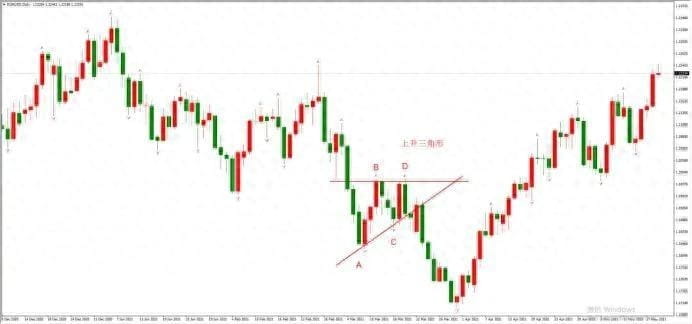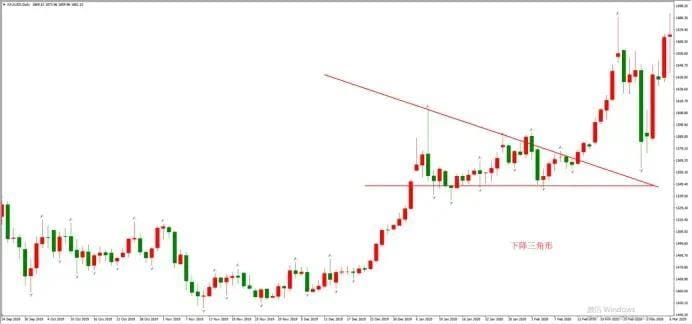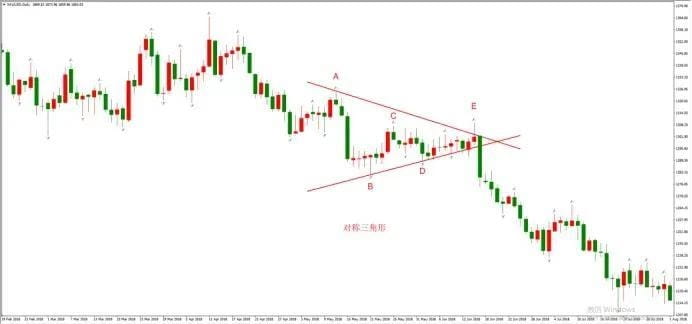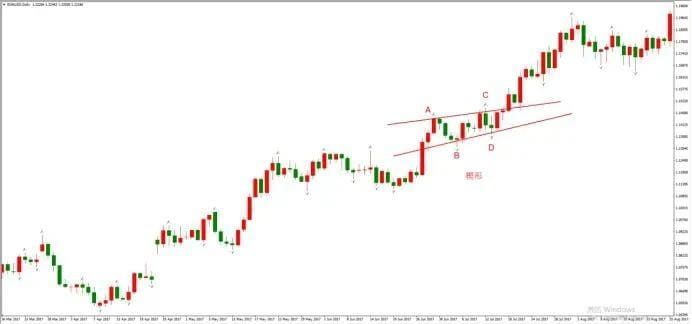When doing structured analysis, we cannot avoid the relevant content of pattern theory. Among all the patterns, the most common one is the triangle consolidation pattern.
It is very important to understand the significance of the triangle consolidation pattern for the future market development. The wedge is also a kind of triangle pattern. As long as the upper and lower lines of the wedge are extended and intersected, a triangle pattern can be obtained.
In order to draw an accurate triangle pattern, you must have some understanding of fractal structure, because fractals are the most effective tool for determining resistance and support points.
01
Ascending Triangle

The straight line above the triangle is formed by connecting two top fractals with basically equal prices. The concept of "basically equal" cannot be defined quantitatively.
The difference between the two top fractals is set to 10 standard points, 20 standard points, 50 standard points, etc. These numbers are not accurate enough. Investors need to understand the spirit of this, and understand the definition of "basic equality" through a lot of replays and rich experience. The straight line below the triangle is formed by connecting the two bottom fractals that are raised successively. The line above the triangle and the line below the triangle are extended and intersect at a certain point, as shown above.
The ascending triangle is composed of four key points, ABCD, where A is the bottom fractal, B is the top fractal, C is the bottom fractal, and D is the top fractal, that is, the top fractal and the bottom fractal are staggered. The structure formed by ABC is easily mistaken for a reversal structure during trading, because traders often think that "the latest low point does not break through the previous low point, which means that the 123 structure is formed and there will be a reversal in the future."
The two high points of BD form an M-top structure. In fact, the ascending triangle and the M-top structure are similar in nature. The ascending triangle means the market is relaying, and after the lower straight line is effectively broken, a short signal is formed. The definition of an effective breakthrough is that the high point of the latest K-line is below the lower straight line of the triangle.
02
Descending Triangle

The principle of the descending triangle is the same as that of the ascending triangle. As shown in the figure, connecting two basically equal bottom fractal points will give you the line below the descending triangle; connecting two successively lower top fractal points will give you the line above the descending triangle.
After the market effectively breaks through the upper resistance line, a buy signal is generated. An effective breakthrough is defined as the lowest point of the latest K-line being higher than the line above the triangle (resistance line). From a practical point of view, the frequency of descending triangles is very low.
03
Symmetrical triangle

The upper resistance line of the symmetrical triangle is formed by connecting two successively lower top fractals, while the lower support line is formed by connecting two successively higher bottom fractals. Moreover, the amplitudes of the successive rises and decreases should be "basically equal".
The extension lines of the resistance line and the support line intersect at one point. As shown in the figure above, the five points ABCDE form a symmetrical triangle. In fact, only four points are needed to form a symmetrical triangle, but the actual market conditions are ever-changing, and a triangle composed of more points can also become a symmetrical triangle after being simplified.
For example, the four points ABCD can draw a symmetrical triangle, but such a symmetrical triangle is proven to be invalid as the market develops, because there is no "long Yang line/long Yin line" to confirm the breakthrough. Only by taking point E into consideration and drawing a new resistance line can we get a valid symmetrical triangle. This "correction" work is necessary because no one can guarantee that the triangle pattern we initially drew will be effective in the future. What traders can do is to do their best to avoid frequent corrections.
04
Wedge

The wedge pattern is rather special. Although it is also formed by connecting two high points and two low points in sequence, the two high points and the two low points must both be "raised in sequence" or "lowered in sequence."
This is similar to a channel line, except that the resistance and support lines are not parallel to each other. For a wedge in a bullish trend, the angle of the support line is steeper than the angle of the resistance line; for a bearish trend, the angle of the resistance line is steeper than the angle of the support line.
Only when the two lines have different inclination angles can they intersect at one point after extension, that is, forming an "elongated" triangle structure. The wedge appears more frequently than the triangle because its requirements for high and low points are not as strict as those of the triangle.
summary
A pattern consisting of two lines, either parallel channel lines; or non-parallel triangular structures (including wedges).
The basis of the hook theory is the hook structure, but the biggest task of the hook structure is to find a reasonable rate line, and then the two rate lines either form a channel line or a triangle structure.
The acquisition of the two lines can help traders determine the stop-loss setting, take-profit setting and entry timing for the current trend. It can be said that the two lines can provide all the trading information that traders need.
Finally, thank you for reading and I wish all my readers good fortune.